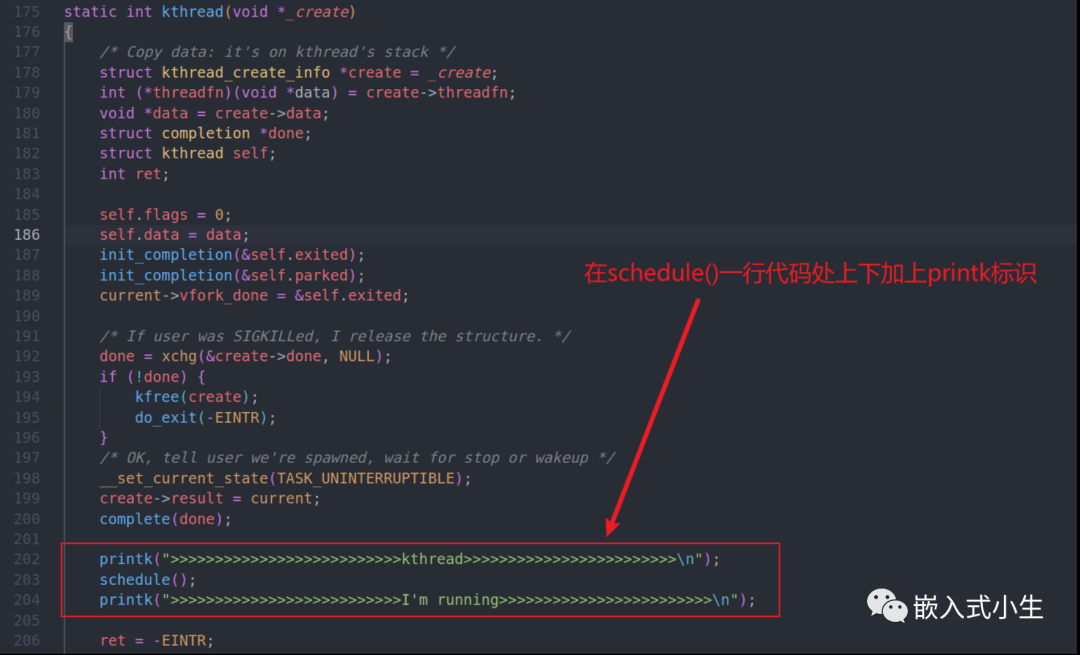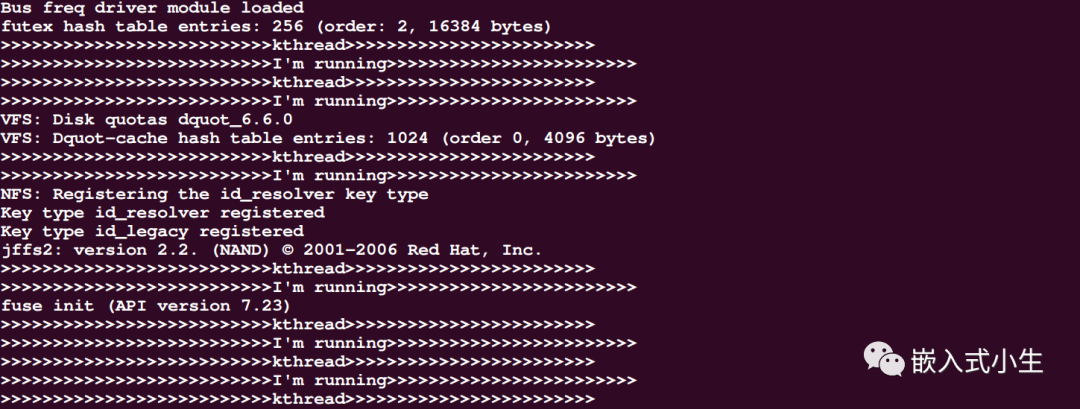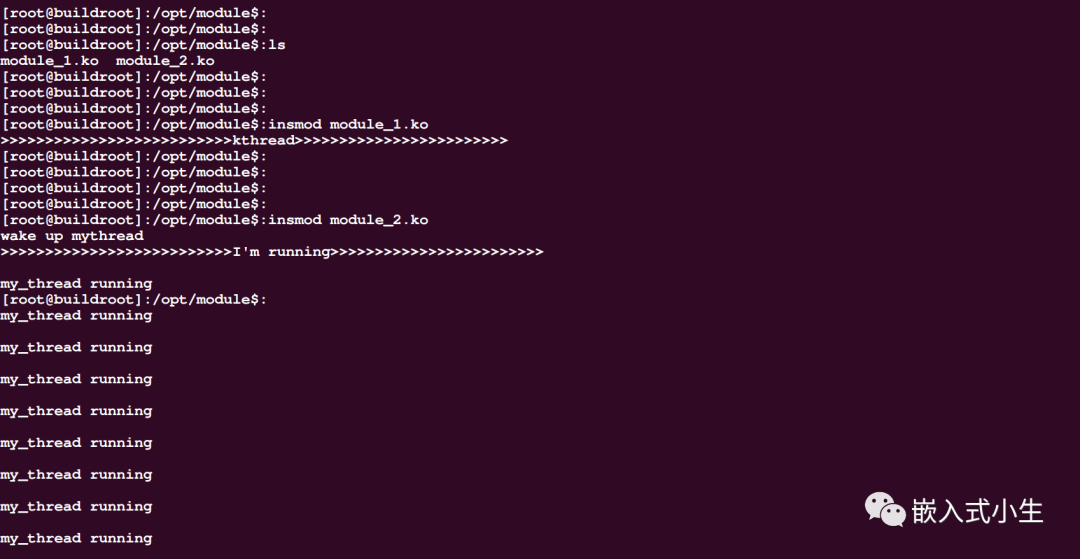

linux内核线程就这样诞生了么?
描述
一、开篇
线程是操作系统的重要组成部件之一,linux内核中,内核线程是如何创建的,在内核启动过程中,诞生了哪些支撑整个系统运转的线程,本文将带着这个疑问瞅一瞅内核源码,分析内核线程的创建机制。本文基于linux内核版本:4.1.15。
与linux内核1号init进程一样,在rest_init()函数中将调用kthread_init()函数创建kthreadd线程,如下代码:
pid = kernel_thread(kthreadd, NULL, CLONE_FS | CLONE_FILES);
下文将看看kthreadd()中完成了哪些事情。
二、kthreadd线程入口分析
kthreadd线程的线程入口为kthreadd(/kernel/kthread.c),如下定义:
int kthreadd(void *unused)
{
struct task_struct *tsk = current;
//该函数会清除当前运行的可执行文件的所有trace,以便启动一个新的trace
set_task_comm(tsk, "kthreadd");
//忽略tsk的信号
ignore_signals(tsk);
//该行代码允许kthreadd在任何CPU上运行
set_cpus_allowed_ptr(tsk, cpu_all_mask);
//设置由alloc_lock保护的内存空间
set_mems_allowed(node_states[N_MEMORY]);
//设置kthreadd线程不应该被冻结
current->flags |= PF_NOFREEZE;
for (;;) {
set_current_state(TASK_INTERRUPTIBLE);
if (list_empty(&kthread_create_list))
schedule();
__set_current_state(TASK_RUNNING);
spin_lock(&kthread_create_lock);
while (!list_empty(&kthread_create_list)) {
struct kthread_create_info *create;
create = list_entry(kthread_create_list.next,
struct kthread_create_info, list);
list_del_init(&create->list);
spin_unlock(&kthread_create_lock);
//该一步是创建内核线程的关键
create_kthread(create);
spin_lock(&kthread_create_lock);
}
spin_unlock(&kthread_create_lock);
}
return 0;
}
上述第3行代码:使用current获取线程控制块。current定义如下(/include/asm-generic/current.h):
#define get_current() (current_thread_info()->task) #define current get_current()
上述代码中16~36行代码:for(;;)是kthreadd的核心功能。使用set_current_state(TASK_INTERRUPTIBLE);将当前线程设置为TASK_INTERRUPTIBLE状态,如果当前没有要创建的线程(这一步由kthread_create_list实现),则主动调用schedule()执行调度,让出CPU,这部分由17~19行代码实现。否则,kthreadd将处于唤醒状态,那么就会执行对应的线程创建操作,这部分功能由23~34行代码实现。
上述代码中,出现了kthread_create_list这个待创建线程的链表,定义如下:
static LIST_HEAD(kthread_create_list);
第26~27行代码,使用:
create = list_entry(kthread_create_list.next, struct kthread_create_info, list);
从链表中取得 kthread_create_info 结构的地址。
第31行代码使用create_kthread()创建create代表的内核线程。定义如下(/kernel/kernel.c):
static void create_kthread(struct kthread_create_info *create)
{
int pid;
#ifdef CONFIG_NUMA
current->pref_node_fork = create->node;
#endif
/* We want our own signal handler (we take no signals by default). */
pid = kernel_thread(kthread, create, CLONE_FS | CLONE_FILES | SIGCHLD);
if (pid < 0) {
/* If user was SIGKILLed, I release the structure. */
struct completion *done = xchg(&create->done, NULL);
if (!done) {
kfree(create);
return;
}
create->result = ERR_PTR(pid);
complete(done);
}
}
从上述代码可知,在create_kthread()中创建线程同样由kernel_thread()函数完成:
pid = kernel_thread(kthread, create, CLONE_FS | CLONE_FILES | SIGCHLD);
可见新创建的线程的入口是kthread,下文将继续分析该线程函数。
三、kthread分析
该函数定义在(/kernel/kthead.c)中:
static int kthread(void *_create)
{
//拷贝数据
//将_create代表的kthread_create_info赋值给create
struct kthread_create_info *create = _create;
//设置线程执行的函数指针
int (*threadfn)(void *data) = create->threadfn;
void *data = create->data;
struct completion *done;
struct kthread self;
int ret;
self.flags = 0;
self.data = data;
init_completion(&self.exited);
init_completion(&self.parked);
current->vfork_done = &self.exited;
/* If user was SIGKILLed, I release the structure. */
done = xchg(&create->done, NULL);
if (!done) {
kfree(create);
do_exit(-EINTR);
}
/* OK, tell user we're spawned, wait for stop or wakeup */
/* 创建的新的内核线程被置为TASK_UNINTERRUPTIBLE,需要显式的被唤醒才能运行 */
__set_current_state(TASK_UNINTERRUPTIBLE);
create->result = current;
complete(done);
//运行到此处,线程已经创建完毕,调用schedule执行调度,主动让出CPU,唤醒的是调用kthread_create函数的进程。
schedule();
//当本线程(创建的线程)被唤醒后,将继续执行后续代码
ret = -EINTR;
if (!test_bit(KTHREAD_SHOULD_STOP, &self.flags)) {
__kthread_parkme(&self);
ret = threadfn(data);
}
/* we can't just return, we must preserve "self" on stack */
do_exit(ret);
}
上述函数中,创建新 thread 的进程恢复运行 kthread_create() 并且返回新创建线程的任务描述符,在创建线程的线程中由于执行了 schedule() 调度,此时并没有执行。需使用wake_up_process(p);唤醒新创建的线程,这时候新创建的线程才得以执行。当线程被唤醒后, 会接着执行threadfn(data)(即:对应线程的真正线程函数)(这一点后文会通过实践加以验证!):
if (!test_bit(KTHREAD_SHOULD_STOP, &self.flags)) {
__kthread_parkme(&self);
//执行创建线程对应的线程函数,传入的参数为data
ret = threadfn(data);
}
总结一下,在kthreadd线程函数中,将完成两件重要的事情:
1、如果kthread_create_list线程创建链表为空,则调用schedule()执行线程调度。
2、如果kthread_create_list线程创建链表不为空(即需要创建线程),则调用create_kthread()创建内核线程。
(1)动手玩一玩
基于上述分析,本小节对其加以实践。
 image-20230709113909381
image-20230709113909381
重新编译构建内核后启动运行,在启动阶段,会打印出下述信息,这属于正常的预期现象,因为内核在启动阶段会涉及到内核重要线程的创建和运行。例如:

接下来以模块方式设计两份代码:
(1)module_1.c:使用kthread_create()创建一个名为my_thread的线程,在线程执行函数中每隔1000ms打印出一行信息:my_thread running。并暴露出对my_thread线程的唤醒接口:
#include#include #include #include #include #include static struct task_struct *my_thread; void wakeup_mythread(void) { // 唤醒内核线程 wake_up_process(my_thread); } EXPORT_SYMBOL(wakeup_mythread); int my_thread_function(void *data) { while (!kthread_should_stop()) { printk("my_thread running "); msleep(1000); } return 0; } static int __init module_1_init(void) { // 创建内核线程 my_thread = kthread_create(my_thread_function, NULL, "my_thread"); if (IS_ERR(my_thread)) { printk(KERN_ERR "Failed to create kernel thread "); return PTR_ERR(my_thread); } return 0; } static void __exit module_1_exit(void) { // 停止内核线程 kthread_stop(my_thread); } module_init(module_1_init); module_exit(module_1_exit); MODULE_AUTHOR("iriczhao"); MODULE_LICENSE("GPL");
(2)module_2.c:调用module_1的wakeup_mythread()唤醒my_thread:
#include#include #include #include extern void wakeup_mythread(void); static int module2_init(void) { printk("wake up mythread "); wakeup_mythread(); return 0; } static void module2_exit(void) { printk("module2_exit exiting "); } module_init(module2_init); module_exit(module2_exit); //定义模块相关信息 MODULE_AUTHOR("iriczhao"); MODULE_LICENSE("GPL");
将上述两份代码以模块方式构建。

从上图中可见:在加载module_1的时候,打印出了:
>>>>>>>>>>>>>>>>>>>>>>>>>>kthread>>>>>>>>>>>>>>>>>>>>>>>>
则证明执行kthread()函数创建了my_thread线程,但是该线程并没有唤醒执行,而由于在kthread()函数中调用schedule()让出了cpu,故而后面的代码没有执行。
当在加载module_2后,则唤醒了my_thread线程,打印出了:
>>>>>>>>>>>>>>>>>>>>>>>>>>I'm running>>>>>>>>>>>>>>>>>>>>>>>>
然后执行my_thread的线程函数,每隔一秒打印出:
my_thread running
综上,也验证了,当在kthread()中调用schedule()时执行线程调度,让出了cpu,当唤醒创建的线程时,会继续执行schedule()后面的代码。
四、总结与补充
(1)kthread_create()函数
通过以上代码分析,可见最重要的是kthread_create_list这个全局链表。当使用kthread_create()函数创建线程时,最终都会将线程相关资源添加到kthread_create_list链表中。如下代码(/include/linux/kthread.h):
#define kthread_create(threadfn, data, namefmt, arg...) kthread_create_on_node(threadfn, data, -1, namefmt, ##arg)
由create_kthread()可知,通过kthread_create()入口进来的内核线程创建路径都具有统一的线程函数kthread()。
而linux内核的2号线程kthreadd正好负责内核线程的调度和管理。所以说创建的内核线程都是直接或间接的以kthreadd为父进程。
(2)kthread_create与kernel_thread的区别
在(init/mian.c)中,1号init线程和2号kthreadd线程都是通过kernel_thread()函数创建的,那么kernel_thread()后续会调用do_fork()实现线程相关的创建操作。kernel_thread()函数与kthread_create()创建的内核线程有什么区别呢?
1、kthread_create()创建的内核线程有干净的上下文环境,适合于驱动模块或用户空间的程序创建内核线程使用,不会把某些内核信息暴露给用户空间程序。
2、二者创建的进程的父进程不同: kthread_create()创建的进程的父进程被指定为kthreadd, 而kernel_thread()创建的进程的父进程可以是init或其他内核线程。
(3)kthread_run()函数
kthread_run()函数用于创建并唤醒一个线程,其本质上是调用kthread_create()创建一个线程,并使用wake_up_process()唤醒该线程。定义如下:
#define kthread_run(threadfn, data, namefmt, ...)
({
struct task_struct *__k
= kthread_create(threadfn, data, namefmt, ## __VA_ARGS__);
if (!IS_ERR(__k))
wake_up_process(__k);
__k;
})
(4)linux内核创建线程的整体过程
综上,linux内核创建线程的整体过程为:
1、创建kthread_create_info结构,为其分配空间,指定线程函数,线程相关描述数据等。
2、将线程的kthread_create_info结构添加到kthread_create_list全局线程创建链表中,并唤醒2号kthreadd线程。
3、2号kthreadd线程将从kthread_create_list全局线程创建链表中取出每一个kthread_create_info结构,然后调用create_kthread()函数创建一个线程函数为kthread的线程。在kthread线程函数中将执行创建线程指定的线程函数。
五、附录
【附录一】
kthread_create_on_cpu()创建一个绑定CPU的线程:
/**
* kthread_create_on_cpu - Create a cpu bound kthread
* @threadfn: the function to run until signal_pending(current).
* @data: data ptr for @threadfn.
* @cpu: The cpu on which the thread should be bound,
* @namefmt: printf-style name for the thread. Format is restricted
* to "name.*%u". Code fills in cpu number.
*
* Description: This helper function creates and names a kernel thread
* The thread will be woken and put into park mode.
*/
struct task_struct *kthread_create_on_cpu(int (*threadfn)(void *data),
void *data, unsigned int cpu,
const char *namefmt)
{
struct task_struct *p;
p = kthread_create_on_node(threadfn, data, cpu_to_node(cpu), namefmt,
cpu);
if (IS_ERR(p))
return p;
set_bit(KTHREAD_IS_PER_CPU, &to_kthread(p)->flags);
to_kthread(p)->cpu = cpu;
/* Park the thread to get it out of TASK_UNINTERRUPTIBLE state */
kthread_park(p);
return p;
}
【附录二】
kthread_create_on_node()函数将操作kthread_create_list链表。kthread_create_on_node()函数的功能是:创建kthread,并将其添加到 kthread_create_list线程创建链表中,并返回对应的task_struct。
struct task_struct *kthread_create_on_node(int (*threadfn)(void *data),
void *data, int node,
const char namefmt[],
...)
{
DECLARE_COMPLETION_ONSTACK(done);
struct task_struct *task;
struct kthread_create_info *create = kmalloc(sizeof(*create),
GFP_KERNEL);
if (!create)
return ERR_PTR(-ENOMEM);
create->threadfn = threadfn;
create->data = data;
create->node = node;
create->done = &done;
spin_lock(&kthread_create_lock);
/*注意这个全局链表kthread_create_list, 所有通过kthread_create创建的内核线程都会挂在这*/
list_add_tail(&create->list, &kthread_create_list);
spin_unlock(&kthread_create_lock);
/*这是最重要的地方,从代码看是唤醒了kthreadd_task这个进程,该进程就是内核中 的1号进程kthreadd 。因为kthreadd_task在rest_init()中通过find_task_by_pid_ns(pid, &init_pid_ns);进行了linux内核的早期赋值 */
wake_up_process(kthreadd_task);
/*
* Wait for completion in killable state, for I might be chosen by
* the OOM killer while kthreadd is trying to allocate memory for
* new kernel thread.
*/
if (unlikely(wait_for_completion_killable(&done))) {
/*
* If I was SIGKILLed before kthreadd (or new kernel thread)
* calls complete(), leave the cleanup of this structure to
* that thread.
*/
if (xchg(&create->done, NULL))
return ERR_PTR(-EINTR);
/*
* kthreadd (or new kernel thread) will call complete()
* shortly.
*/
wait_for_completion(&done);
}
task = create->result;
if (!IS_ERR(task)) {
static const struct sched_param param = { .sched_priority = 0 };
va_list args;
va_start(args, namefmt);
vsnprintf(task->comm, sizeof(task->comm), namefmt, args);
va_end(args);
/*
* root may have changed our (kthreadd's) priority or CPU mask.
* The kernel thread should not inherit these properties.
*/
sched_setscheduler_nocheck(task, SCHED_NORMAL, ¶m);
set_cpus_allowed_ptr(task, cpu_all_mask);
}
kfree(create);
return task;
}
kthread_create_on_node()函数的本质则是创建kthread_create_info结构,并将其添加到kthread_create_list全局链表中(/kernel/kthread.h):
struct kthread_create_info
{
/* 从kthreadd传递给kthread()的信息 */
int (*threadfn)(void *data);
void *data;
int node;
/* 从kthreadd返回给kthread_create()的结果 */
struct task_struct *result;
struct completion *done;
struct list_head list;
};
审核编辑:刘清
-
鸿蒙内核源码Task/线程技术分析2020-10-18 3039
-
Linux下线程编程2022-08-24 2391
-
linux 下如何获取线程ID2019-07-09 3157
-
请问大佬rt-thread smart用户程序可以创建实时线程么?2022-04-15 4907
-
Linux的内核教程2009-04-10 528
-
多线程编程之Linux线程编程2017-10-18 997
-
如何配置和使用Linux内核printk功能2018-11-27 3553
-
Linux内核线程优先级设置的方法介绍2019-04-23 6381
-
嵌入式linux内核开发培训之linux特性2019-05-12 1015
-
linux线程浅析2019-04-02 430
-
为什么说内核线程放入SCHED_FIFO的做法毫无意义?2020-06-09 5183
-
linux内核参数设置_linux内核的功能有哪些2020-09-17 1627
-
深入浅析Linux内核之内核线程(上)2021-04-28 2577
-
嵌入式Linux经典书籍、内核书籍2021-11-01 785
-
linux多线程编程实例2024-02-15 1112
全部0条评论

快来发表一下你的评论吧 !

